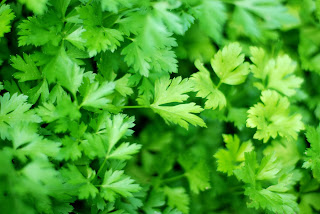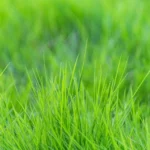
Parsley is a herbaceous plant in the same family as celery, carrot, and cumin (Apiaceae). The precise origin of parsley is unknown. According to some researchers, parsley originated in Sardinia. Parsley cultivation began over 2000 years ago. This plant can now be found all over the world. Parsley prefers areas with partial shade and well-drained, mineral-rich soil. The flavor of parsley is determined by the type of soil and climate conditions. Parsley is one of the world’s most popular spices. Parsley is also used in the cosmetic, pharmaceutical, and medical industries.
Parsley can reach a height of 2 feet.
The bright green, fern-like leaves of parsley grow from a centrally positioned green stem. Leaf stems are more flavorful than leaves.
There are two basic types of parsley, which differ in flavor and leaf morphology. Curly parsley has wrinkled or creased leaves and is bitter. The leaves of Italian parsley are flat and have a strong flavor.
Parsley produces tiny flowers in terminal inflorescences known as umbels.
Hamburg parsley is a type of parsley with large roots (6 times bigger than the plant). The root of Hamburg parsley is consumed by humans, but it is less popular than the leaves.
The germination period of parsley is extended (at least one month). Gardeners like to grow parsley near roses (to keep them healthy and to enhance their fragrance) and tomatoes (because parsley attracts bees – main pollinators of tomatoes).
Parsley is high in vitamins K, C, and A, as well as B vitamins. It also has fiber and minerals like potassium, magnesium, calcium, and iron.
In ancient Rome, parsley was used as a salad ingredient, to relieve hangover symptoms, and as a head ornament in the form of garlands.
Parsley is one of the world’s most popular herbs. It is used in salads, soups, stews, and dishes with tomato, meat, and fish.
Chewing parsley can help eliminate bad breath, especially after consuming garlic.
Animal studies revealed that parsley oil has antitumor properties (prevents growth of tumor).
Parsley is anti-bacterial (kills bacteria) and anti-fungal (kills fungi). Parsley tea improves blood circulation. Leaves can be used to treat superficial wounds, and root juice can be used to reduce swelling. However, pregnant women should avoid parsley because it causes uterine contractions, which can lead to miscarriage.
Parsley is used in the cosmetic industry to make soaps and body lotions that are especially beneficial to dry skin.
Parsley is a biennial plant, which means it has a two-year life cycle.
Parsley FAQs: Unveiling the Versatility of this Leafy Green
Parsley, often relegated to a garnish on our plates, is a nutritional powerhouse with a surprising range of uses. Let’s delve into some frequently asked questions about this versatile herb:
1. What are the different types of parsley?
There are three main types of parsley commonly found in grocery stores:
- Curly Parsley: This is the most recognizable variety, with abundant, frilled green leaves. It has a stronger flavor than other types and is often used as a garnish or chopped into salads.
- Flat-leaf Parsley (Italian Parsley): This variety has flat, broad leaves with a more delicate flavor than curly parsley. It’s a popular choice for cooking as its taste doesn’t overpower other ingredients.
- Hamburg Parsley: This type is grown for its parsnip-like root, used in some European dishes. The leaves are similar to flat-leaf parsley but with a slightly stronger taste.
2. What are the health benefits of parsley?
Parsley packs a punch of nutrients for its small size. Here are some of its health benefits:
- Rich in Vitamins and Minerals: Parsley is an excellent source of vitamins A, C, and K. It also contains essential minerals like folate, potassium, and manganese.
- Antioxidant Powerhouse: Parsley is loaded with antioxidants that help protect your cells from damage.
- May Aid Digestion: Parsley’s volatile oils may help stimulate digestion and reduce bloating.
- Bone Health: The vitamin K content in parsley plays a crucial role in maintaining strong bones.
- Freshens Breath: Chewing on a sprig of parsley can help neutralize bad breath thanks to its chlorophyll content.
3. How can I incorporate parsley into my diet?
Parsley’s versatility goes beyond just a garnish! Here are some ways to enjoy its flavor and health benefits:
- Salads and Dips: Finely chop parsley and add it to your favorite salads, dips, or potato salad for a burst of freshness.
- Soups and Stews: Throw in a handful of parsley towards the end of cooking soups, stews, or chilis for added flavor and nutrients.
- Sauces and Dressings: Parsley can be a delightful addition to pesto, chimichurri sauce, or homemade salad dressings.
- Roasted Vegetables: Toss chopped parsley with vegetables like carrots, potatoes, or broccoli before roasting for extra flavor.
- Seafood and Chicken: Parsley pairs well with fish, shrimp, or chicken. Add it during cooking or sprinkle it on top before serving.
- Juices and Smoothies: For a nutrient boost, add a few parsley leaves to your next green juice or smoothie.
4. How to store parsley?
Store fresh parsley like any other leafy green. Wash it thoroughly, pat it dry, and wrap it loosely in a paper towel or place it in a plastic bag with a few holes for air circulation. Store it in the refrigerator crisper drawer for up to a week.
5. Can I freeze parsley?
Yes, you can freeze parsley to extend its shelf life. Here are two methods:
- Blanching: Briefly blanch parsley leaves in boiling water for 30 seconds, then shock them in ice water. Drain well, pat dry, and freeze in airtight containers for up to 6 months.
- Chopped and Frozen: Finely chop fresh parsley and place it in ice cube trays. Fill each compartment with water and freeze. Once frozen, pop the parsley cubes into an airtight container or freezer bag for up to a year.
6. Can parsley be harmful?
Parsley is generally safe for most people in moderate amounts. However, excessive consumption, particularly of the juice, might cause side effects like nausea or vomiting. It’s best to consult your doctor if you have any concerns, especially if you are pregnant or breastfeeding.
7. Is parsley a good substitute for cilantro?
Parsley and cilantro have distinct flavors. While parsley offers a refreshingly green taste, cilantro has a more citrusy and pungent aroma. They can be used interchangeably in a pinch, but the dish might not have the same flavor profile.
8. Can I grow parsley at home?
Absolutely! Parsley is a relatively easy herb to grow indoors or outdoors in pots. It thrives in well-drained soil and prefers around 6 hours of sunlight daily.









